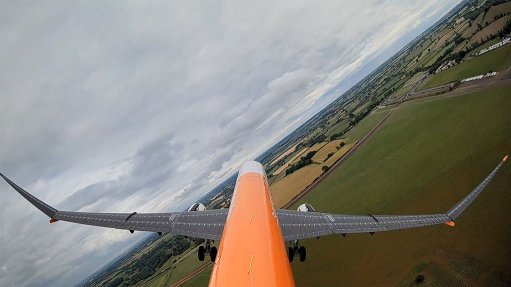
The AlbatrossONE UAV in flight, with the hinged wingtips clearly visible
Photo by: Airbus
Europe-based global major aerospace group Airbus reported on Wednesday on the achievement of a new milestone by its AlbatrossONE technology demonstration project. Inspired by the wonderful aerodynamics of the very far ranging Albatross seabird, the AlbatrossONE project is using a small-scale, remotely-controlled, unmanned aerial vehicle (UAV) to test the concept of freely flapping wingtips.
The UAV’s airframe configuration is that of a twin-engined airliner (it looks like a big remotely-controlled model aircraft). The new milestone was the achievement of what Airbus called a ‘gate-to-gate’ demonstration, using freely flapping wingtips that were 75% longer than those used in Phase 1 of the project. Freely flapping wingtips have the potential to improve aircraft performance by alleviating wing loads and avoiding tip stalls.
(In a stall, the angle at which the relative airflow meets the wing becomes so steep that it no longer flows smoothly over the wing and therefore ceases to generate lift. But this does not necessarily happen over the entire wing in one go. Stall conditions can occur at the wingtips only, with the rest of the wings continuing to generate lift; such tip stalls can reduce the efficiency of the aircraft’s ailerons, thereby hampering its flight performance.)
“[The] ‘gate-to-gate’ demonstration …. involves moving the wingtips from vertical to horizontal position before flight, and back again after flight,” explained AlbatrossONE chief engineer James Kirk. “We also enabled the wingtips to flap just before lift-off to improve roll control and navigate a high load during flight. They were then locked into planar for efficient cruise.”
“The ‘gate-to-gate’ demonstration also enabled us to prove freely flapping wingtips can alleviate wing loads, while increasing roll rate compared to fixed wingtips and avoiding tip stall during landing,” elucidated Airbus Semi-Aeroelastic Hinge Project leader Tom Wilson. “During a separate flight, we also demonstrated how to safely land an aircraft using freely flapping wingtips without hitting the ground or stops.”
The freely flapping wingtips are more formally called semi-aeroelastic hinged wingtips. They allow the aspect ratio of a wing to be increased. The aspect ratio is the ratio of the wing span to the wing chord (width). More aspect ratio means less aerodynamic drag. Today, jet airliners have an aspect ratio of 9 or 10; flapping wingtips would allow this to be increased to about 18 (which is the same aspect ratio of the wings of the largest species of Albatross). Reducing drag reduces fuel burn, which also reduces carbon dioxide emissions.
“Semi-aeroelastic hinged wingtips enable an aircraft to ‘surf’ through wind gusts without transferring the bending loads (i.e. external load that produces bending stresses within a body) to the main wing,” pointed out Kirk. “This means we require less material, such as carbon-fibre-reinforced polymers, to make the wing strong enough to withstand the gust loads, thus reducing the weight of the aircraft. Also, the length of the wingtip can be extended without adding weight to the wing because the extra loads from the longer wingtip are not passed to the main wing.”
The successful conclusion of Phase 2 of the project means that it has achieved ‘proof-of-concept’ at a small scale. The next step is to mature the technology at a larger scale. “There’s still a lot of engineering work required before we can prove it’s a viable product,” cautioned Kirk. “But the project team is motivated to achieve this goal and to inspire other engineers to think ambitiously about future aircraft.”